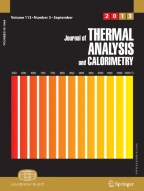Abstract
In order to explore the law of polymorphic transformation in the process of preparing hexanitrohexaazaisowurtzitane (CL-20)-based composite explosives in cast-cured method, the polymorphic transition of CL-20 crystal under heat stimulation was investigated by X-ray diffraction and differential scanning calorimetric method, respectively, and the effects of different addictives (mainly involved in castable systems) on polymorphic transition of CL-20 were elaborately explored. The transition mechanism was systemically analyzed from the point of view of kinetic and thermodynamic. The experiment results showed that the polymorphic transition was closely related to temperature and ambient surroundings, and the influence of different additives was not consistent in the process of polymorphic transition. In addictives with higher dipole moment or solubility of CL-20, ε-form could easily be polarized and tend to transform into γ-form and the process occurred in fluid medium was much easier than that in solid matrix. The investigation contributes to comprehend the polymorphic transformation mechanism of CL-20 and provides guidance for effective control on the CL-20 polymorphs in preparing CL-20-based composite explosives.










Similar content being viewed by others
References
Nielsen AT. Synthesis of polynitropolyaza caged nitramines. chemical propulsion information agency; 1987, Publication no.473.
Nielsen AT. Caged polynitramine compound, US patent 5693794. United States Dept. of the Navy, USA. 1997.
Simpson RL, Urtiev PA, Ornellas DL, et al. CL-20 performance exceeds that of HMX and its sensitivity is moderate [J]. Propellant Explos Pyrotech. 1997;22(5):249–55.
Bolotina NB, Hardie MJ, Speer RL, et al (2004) Energetic materials: variable-temperature crystal structures of γ- and ε-HNIW polymorphs. J Appl Cryst 37:808.
ter Host JH, Kramer HJM, van Rosmalen GM, Jansens PJ. Molecular modelling of polymorphs. HMX polymorphs. J Cryst Growth. 2002;237–239:2215–20.
Sikder AK, Sikder N. A review of advanced high performance, insensitive and thermally stable energetic materials emerging for military and space applications. J Hazard Mater. 2004;112:1–15.
Sivabalan R, Gore GM, Nair UR, Saikia A, Venugopalan S, Gandhe BR. Study on ultrasound assisted precipitation of CL-20 and its effect on morphology and sensitivity. J Hazard Mater. 2007;139:199–203.
Vrcelj RM, Gallagher HG, Sherwood JN. Polymorphism in 2,4,6-trinitrotoluene cryatallized from solution. J Am Chem Soc. 2001;123:2291–5.
Vrcelj RM, Sherwood JN, Kennedy AR, Gallagher HG, Gelbrich T. Polymorphism in 2,4,6-trinitrotoluene. Cryst Growth Des. 2003;3:1027–31.
Gallaghera HG, Vrceljb RM, Sherwood JN. The crystal growth and perfection of 2,4,6-trinitrotoluene. J Cryst Growth. 2003;250:486–98.
Parrish DA, Deschamps JR, Gilardi RD, Butcher RJ. Polymorphs of picryl bromide. Cryst Growth Des. 2008;8:57–62.
Ciezak JA, Jenkins TA, Liu Z. Evidence for a high-pressure phase transition of ε-2,4,6,8,10,12-hexanitrohexaazaisowurtzitane (CL-20) using vibrational spectroscopy. Propellants Explos Pyrotech. 2007;32(6):472–7.
Lee M-H, Kim J-H, Park Y-C, et al. Control of crystal density of ε-hexanitrohexaazaisowurzitane in evaporation crystallization. Ind Eng Chem Res. 2007;46:1500–4.
Jiang X, Guo X, Ren H, et al. Control of particle Size and shape of ε-HNIW in drowning-out crystallization. J Chem Eng Jpn. 2012;45(6):380–6.
Jiang X, Guo X, Ren H, et al. Preparation and characterization of desensitized ε-HNIW in solvent–antisolvent recrystallizations. Cent Eur J Energ Mater. 2012;9(3):139–46.
Yu L, Jiang X, Guo X, et al. Effects of binders and graphite on the sensitivity of ε-HNIW. J Therm Anal Calorim. 2013;112:1343–9.
Yan Q-L, Zeman S, Svoboda R, et al. The effect of crystal structure on the thermal reactivity of CL-20 and its C4-bonded explosives. J Therm Anal Calorim. 2013;112(2):837–49.
Mei X, Jiao Q, Zhu Y, et al. Thermal study of HNIW and mixtures containing aluminum powder. J Therm Anal Calorim. 2014. doi:10.1007/s10973-013-3625-y.
Ordzhonikidze O, Pivkina A, Frolov Yu, Muravyev N, Monogarov K. Comparative study of HMX and CL-20. J Therm Anal Calorim. 2011;105:529–34.
Jin S, Shu Q, Chen S, et al. Preparation of ε-HNIW by a one-pot method in concentrated nitric acid from tetraacetyldiformylhexaazaisowurzitane. Propellants Explos Pyrotech. 2007;32(6):468–71.
Prakash V. Influence of aluminium on performance of HTPB-based aluminised PBXs. Def Sci J. 2004;54(4):475–82.
Kumar AS, Rao VB. Evaluation of plastic bonded explosive (PBX) formulations based on RDX, aluminum, and HTPB for underwater applications. Propellants Explos Pyrotech. 2010. doi:10.1002/prep.200800048.
Nair UR, Sivabalan R, Gore GM, et al. Hexanitrohexaazaisowurtzitane (CL-20) and CL-20 based formulations. Combus Explos Shock Waves. 2005;41(2):121–32.
Li J, Brill TB. Kinetics of solid polymorphic phase transitions of CL-20. Propellants Explos Pyrotech. 2007;32(4):326–30.
Turcotte R, Vachon M, Kwok QSM, et al. Thermal study of HNIW. Thermochim Acta. 2005;433:105–15.
Gumpa JC, Peiris SM. Phase transitions and isothermal equations of state of epsilon hexanitrohexaazaisowurtzitane(CL-20). J Appl Phys. 2008;104:083509.
Tian Q, Yan G, Sun G, et al. Thermally induced damage in hexanitrohexaazaisowurtzitane. Cent Eur J Energ Mater. 2013;10(3):359–69.
Acknowledgements
We would like to express our gratitude to Dr. Jie Sun for his enthusiastic help in this work.
Author information
Authors and Affiliations
Rights and permissions
About this article
Cite this article
Zhang, P., Xu, Jj., Guo, Xy. et al. Effect of addictives on polymorphic transition of ε-CL-20 in castable systems. J Therm Anal Calorim 117, 1001–1008 (2014). https://doi.org/10.1007/s10973-014-3798-z
Received:
Accepted:
Published:
Issue Date:
DOI: https://doi.org/10.1007/s10973-014-3798-z



